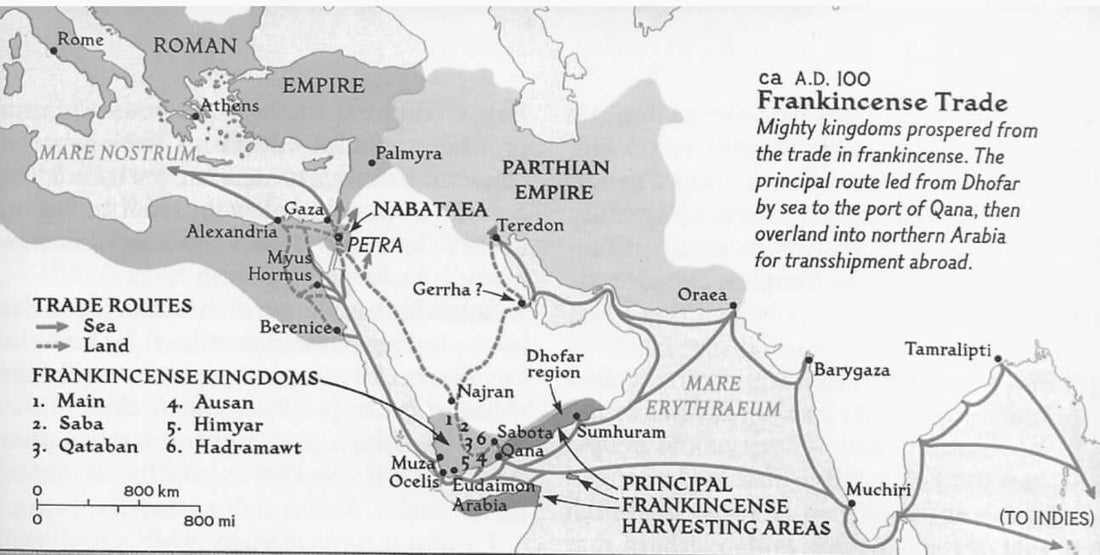
Frankincense in Ancient History: The Incense Trade
Awaken To The OneShare
Frankincense in Ancient History: The Incense Trade
Frankincense, derived from the Boswellia sacra tree native to the Arabian Peninsula, has a rich history that dates back thousands of years. Once considered a rare and highly sought-after commodity, it played a pivotal role in the ancient incense trade, influencing cultures across the world. Its journey from sacred rituals to the marketplace is one of the most fascinating stories of antiquity, intertwining religion, commerce, and exploration. In this blog, we’ll delve into the significance of frankincense in ancient history, exploring its role in the incense trade, its impact on ancient civilizations, and how it shaped the world as we know it today.
The Origins of Frankincense and Its Sacred Nature
Frankincense has long been associated with the divine. The resin is obtained by making incisions into the bark of the Boswellia sacra tree, where the resin then seeps out and hardens. This precious substance, with its rich and aromatic scent, was considered a gift from the gods by the ancient peoples of the Arabian Peninsula, particularly in Oman, where it still grows today. The sacred nature of frankincense meant that it was often used in religious ceremonies, burned as incense to honor the gods, and employed in embalming rituals for its purifying properties.
In fact, ancient texts and myths across cultures often allude to frankincense’s divine status. In the Old Testament of the Bible, frankincense is mentioned as one of the gifts brought by the Three Wise Men to the infant Jesus, along with gold and myrrh. This spiritual connection is seen throughout history, with frankincense being an essential part of rituals in religions such as Judaism, Christianity, and Islam. Its fragrant smoke was believed to carry prayers to the gods, and its use in temples and altars was a form of divine communication.
The Incense Route: Frankincense as a Trade Commodity
Frankincense was not only important for its spiritual significance but also as a valuable trade commodity. By the first millennium BCE, frankincense was being traded across vast distances, forming an integral part of a lucrative trade network known as the Incense Route. This trade route was a network of pathways used by merchants and traders to transport frankincense, myrrh, and other aromatic resins, as well as spices and precious metals, from the Arabian Peninsula to regions in the Mediterranean, Egypt, India, and even parts of East Africa.
The trade in frankincense was particularly significant to the ancient civilizations of the Near East and Mediterranean. Oman, Yemen, and parts of Somalia were the primary sources of frankincense, and these regions became incredibly wealthy from the sale of their resin. The city of Sumhuram, located in present-day Oman, was a major port along the Incense Route and played a vital role in the trade of frankincense. The strategic location of these trading hubs allowed merchants to exchange frankincense for gold, silver, ivory, and textiles, fueling the economic growth of the region.
One of the most notable ancient civilizations to benefit from the frankincense trade was that of the Nabateans. This Arabian people established a kingdom in modern-day Jordan and Saudi Arabia, with Petra as their capital. Petra, a city known for its rock-hewn architecture, was a key stop along the Incense Route, and the Nabateans were instrumental in controlling the flow of frankincense and other valuable goods. The wealth generated by the frankincense trade allowed them to build a thriving kingdom that flourished for centuries.
The Romans and Greeks were also significant players in the frankincense trade, with frankincense being an important part of Roman religious and cultural life. The emperor Augustus even established a monopoly on the trade of frankincense, recognizing its value not only as an offering to the gods but also as a symbol of prestige and power. The Roman Empire’s demand for frankincense was so great that it necessitated a steady supply from the Arabian Peninsula, leading to the establishment of major ports along the Red Sea to facilitate its import.
Frankincense in Ancient Egypt: A Royal Resin
Perhaps no civilization valued frankincense more than the ancient Egyptians. The resin was used extensively in religious ceremonies and as part of the mummification process. Frankincense was believed to have purifying properties, and its smoke was said to be able to communicate with the gods, creating a bridge between the physical and divine worlds. As a result, frankincense was often burned in temples and palaces, symbolizing the presence of the gods during religious ceremonies.
Additionally, frankincense was used in the embalming process, as Egyptians believed that its aroma helped preserve the body and soul for the afterlife. The resin’s preservation qualities made it a valuable addition to the embalming ritual, alongside myrrh and other sacred substances. Many tombs and burial sites, including the famous tomb of Tutankhamun, have been found to contain traces of frankincense, further highlighting its importance in Egyptian culture.
Frankincense was also used in cosmetics and perfumes by the Egyptians. The resin’s pleasant scent was believed to have a calming effect, and it was often used in the creation of oils and balms to beautify the skin. The high demand for frankincense in Egypt led to the creation of trade routes between Egypt and the Arabian Peninsula, ensuring a continuous supply of the precious resin.
Frankincense and the Spice Trade: Economic and Cultural Impact
The incense trade not only contributed to the economies of the Arabian Peninsula but also had a profound impact on the cultures of the ancient world. The exchange of frankincense led to cross-cultural exchanges and the spread of ideas, technology, and artistic traditions.
As frankincense made its way across the Incense Route, it brought with it the knowledge of its cultivation, harvesting, and use. The incense trade also facilitated the spread of religious ideas, particularly as the resin was used in temples and places of worship across different civilizations. The Egyptians, Greeks, and Romans, for instance, all adopted the practice of burning frankincense in religious rituals, though each adapted it to their own cultural and spiritual beliefs.
The trade of frankincense also contributed to the spread of other goods, such as spices, silks, and precious stones, leading to the development of the larger Silk Road and spice trade routes. The exchange of these goods helped foster an interconnected world long before the rise of modern globalization.
Decline of the Incense Trade and the Legacy of Frankincense
Over time, the demand for frankincense began to decline, particularly after the rise of the Islamic Caliphate in the 7th century CE, which disrupted the established trade routes. The discovery of new maritime routes by European explorers in the 15th and 16th centuries further shifted the balance of trade, and the importance of frankincense as a commodity gradually diminished.
However, the legacy of frankincense endures. Its cultural and historical significance continues to be celebrated, and it remains a valuable resource in modern times. Today, frankincense is still used in religious ceremonies and rituals, and its essential oil is prized for its therapeutic properties. The incense trade, though not as prominent as it once was, still plays an important role in the economy of countries like Oman, where the resin is harvested sustainably and exported around the world.
Conclusion: Frankincense’s Lasting Impact on Ancient History
Frankincense played an irreplaceable role in ancient history, shaping cultures, economies, and religious practices. From the sacred rituals of the Egyptians to the wealth of the Nabateans, frankincense connected distant civilizations and bridged cultures. Its journey along the Incense Route symbolizes the exchange of goods, ideas, and traditions that helped shape the ancient world.
While the ancient incense trade has faded, the historical and cultural legacy of frankincense continues to thrive. Today, we still recognize frankincense as more than just a fragrant resin; it is a symbol of ancient commerce, spirituality, and cultural exchange. As we burn a stick of frankincense or use it in a skincare product, we’re connecting with the past—a past where frankincense was not just an item for sale, but a sacred gift from the gods.
